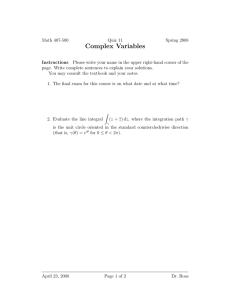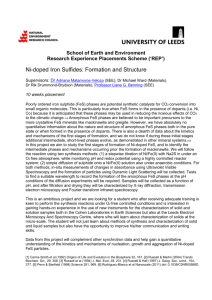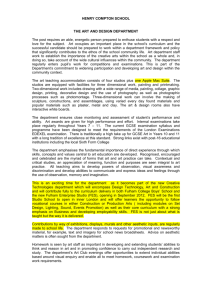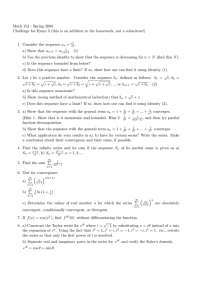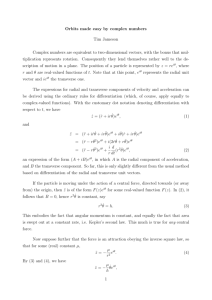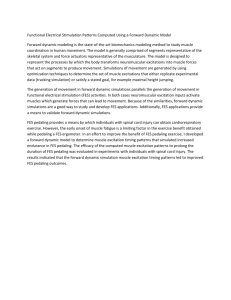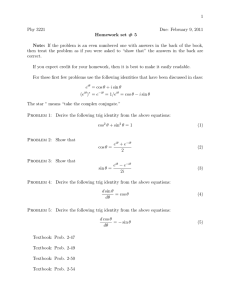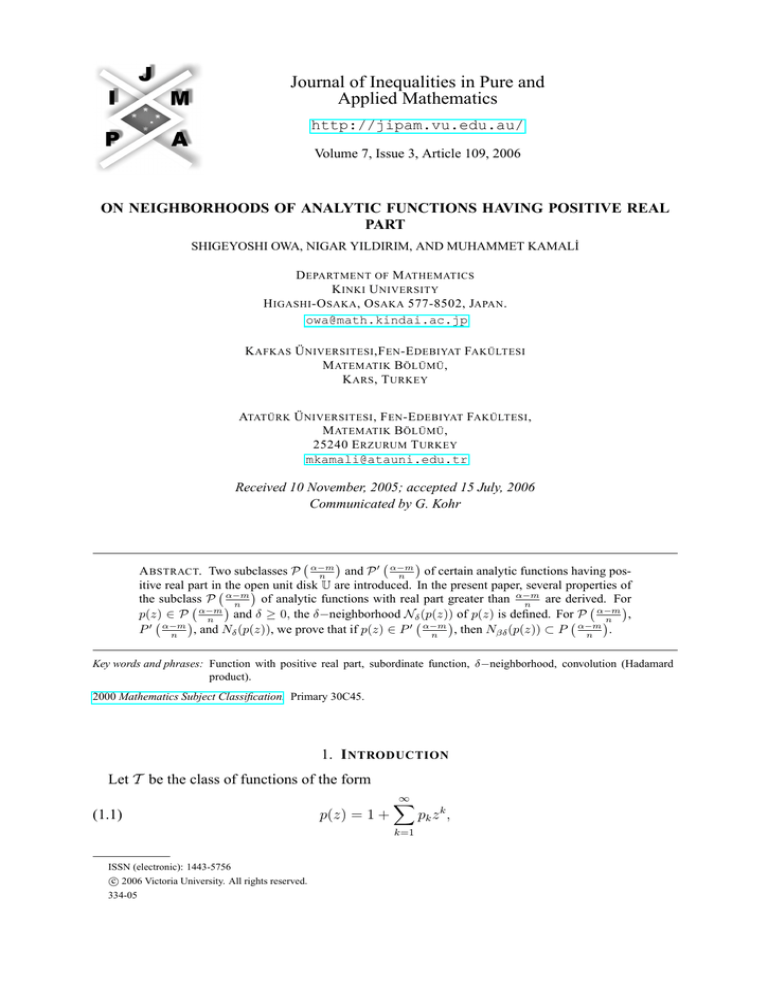
Journal of Inequalities in Pure and
Applied Mathematics
http://jipam.vu.edu.au/
Volume 7, Issue 3, Article 109, 2006
ON NEIGHBORHOODS OF ANALYTIC FUNCTIONS HAVING POSITIVE REAL
PART
SHIGEYOSHI OWA, NIGAR YILDIRIM, AND MUHAMMET KAMALİ
D EPARTMENT OF M ATHEMATICS
K INKI U NIVERSITY
H IGASHI -O SAKA , O SAKA 577-8502, JAPAN .
owa@math.kindai.ac.jp
K AFKAS Ü NIVERSITESI ,F EN -E DEBIYAT FAKÜLTESI
M ATEMATIK B ÖLÜMÜ ,
K ARS , T URKEY
ATATÜRK Ü NIVERSITESI , F EN -E DEBIYAT FAKÜLTESI ,
M ATEMATIK B ÖLÜMÜ ,
25240 E RZURUM T URKEY
mkamali@atauni.edu.tr
Received 10 November, 2005; accepted 15 July, 2006
Communicated by G. Kohr
A BSTRACT. Two subclasses P α−m
and P 0 α−m
of certain analytic functions having posn
n
itive real part in the open
unit
disk
U
are
introduced.
In
the present paper, several properties of
the subclass P α−m
of
analytic
functions
with
real
part
greater than α−m
are derived. For
n
n
α−m
p(z) ∈ P n
and δ ≥ 0, the δ−neighborhood Nδ (p(z)) of p(z) is defined. For P α−m
n
,
α−m
0 α−m
0 α−m
P
, and Nδ (p(z)), we prove that if p(z) ∈ P
, then Nβδ (p(z)) ⊂ P
.
n
n
n
Key words and phrases: Function with positive real part, subordinate function, δ−neighborhood, convolution (Hadamard
product).
2000 Mathematics Subject Classification. Primary 30C45.
1. I NTRODUCTION
Let T be the class of functions of the form
(1.1)
p(z) = 1 +
∞
X
k=1
ISSN (electronic): 1443-5756
c 2006 Victoria University. All rights reserved.
334-05
pk z k ,
2
S HIGEYOSHI OWA , N IGAR Y ILDIRIM ,
AND
M UHAMMET K AMALI
which are analytic in the
open unit disk U = {z ∈ C : |z| < 1}. A function p(z) ∈ T is said to
α−m
be in the class P n if it satisfies
α−m
(z ∈ U)
n
for some m ≤ α < m + n, m ∈ N0 = 0, 1, 2, 3, . . . , and n ∈ N = 1, 2, 3, . . . . For any
p(z) ∈ P α−m
and δ ≥ 0, we define the δ−neighborhood Nδ (p(z)) of p(z) by
n
)
(
∞
∞
X
X
Nδ (p(z)) = q(z) = 1 +
qk z k ∈ T :
|pk − qk | ≤ δ .
Re {p(z)} >
k=1
k=1
The concept of δ−neighborhoods Nδ (f (z)) of analytic functions f (z) in U with f (0) = f 0 (0)−
1 = 0 was fırst introduced by Ruscheweyh [12] and was studied by Fournier [4, 6] and by Brown
[2]. Walker has studied the δ1 −neighborhood Nδ1 (p(z)) of p(z) ∈ P1 (0) [13]. Later, Owa et
al. [9] extended the result by Walker.
α−m
. Furthermore, we define a
In this paper, we give some inequalities
for
the
class
P
n
0 α−m
neighborhood of p(z) ∈ P
and determine δ > 0 so that Nβδ (p(z)) ⊂ P α−m
, where
n
n
m+n−α
β= n .
2. S OME I NEQUALITIES FOR THE C LASS P α−m
n
α−m
Our first result for functions p(z) in P n is contained in
Theorem 2.1. Let p(z) ∈ P α−m
. Then, for |z| = r < 1, m ≤ α < m + n, m ∈ N0 and
n
n ∈ N,
2r
α−m
0
(2.1)
|zp (z)| ≤
Re p(z) −
.
1 − r2
n
For each m ≤ α < m + n, the equality is attained at z = r for the function
α−m
α−m 1−z
2
p(z) =
+ 1−
= 1 − (n − α + m) z + · · · .
n
n
1+z
n
Proof. Let us consider the case of p(z) ∈ P(0). Then the function k(z) defined by
k(z) =
1 − p(z)
= η1 z + η2 z 2 + · · ·
1 + p(z)
is analytic in U and |k(z)| < 1 (z ∈ U). Hence k(z) = zΦ(z), where Φ(z) is analytic in U and
|Φ(z)| ≤ 1 (z ∈ U). For such a function Φ(z), we have
2
1
−
|Φ(z)|
(2.2)
|Φ0 (z)| ≤
(z ∈ U).
1 − |z|2
From zΦ(z) =
(i)
1−p(z)
,
1+p(z)
we obtain
1
|Φ(z)| = 2
r
2
1 − p(z) 2
1 + p(z) ,
(ii)
1
|Φ (z)| = 2
r
0
J. Inequal. Pure and Appl. Math., 7(3) Art. 109, 2006
2zp0 (z) + (1 − p2 (z)) ,
(1 + p(z))2
http://jipam.vu.edu.au/
N EIGHBORHOODS OF A NALYTIC F UNCTIONS
3
where |z| = r. Substituting (i) and (ii) into (2.2), and then multiplying by |1 + p(z)|2 we obtain
2
2
2
0
2zp (z) + (1 − p2 (z)) ≤ r |1 + p(z)| − |1 − p(z)| ,
1 − r2
which implies that
r2 |1 + p(z)|2 − |1 − p(z)|2
2
|2zp (z)| ≤ (1 − p (z)) +
.
1 − r2
Thus, to prove (2.1) (with α = m), it is sufficient to show that
0
(2.3)
2
2
2
(1 − p2 (z)) + r |1 + p(z)| − |1 − p(z)| ≤ 4r Re p(z) .
1 − r2
1 − r2
Now we express |1 + p(z)|2 , |1 − p(z)|2 and Re p(z) in terms of |1 − p2 (z)|. From zΦ(z) =
1−p(z)
we obtain that
1+p(z)
(iii) |1 − p(z)|2 = |1 − p2 (z)| |zΦ(z)|
and
(iv) |1 + p(z)|2 |zΦ(z)| = 1 − Re2 (z) .
From (iii) and (iv) we have
(v)
"
#
2
1
−
|zΦ(z)|
4 Re p(z) = |1 + p(z)|2 − |1 − p(z)|2 = 1 − p2 (z)
.
|zΦ(z)|
Substituting (iii), (iv), and (v) into (2.3), and then cancelling |1 − p2 | we obtain
r2
(1 − p2 (z)) +
|1−p2 (z)|
|zΦ(z)|
− |1 − p2 (z)| |zΦ(z)|
1 − r2
4 Re p(z) + (1 − r2 ) |1 − p2 (z)| 1 −
=
1
|zΦ(z)|
1 − r2
4r Re p(z)
,
1 − r2
which gives us that the inequality (2.1) holds true when α = m. Further, considering the
function w(z) defined by
p(z) − ( α−m
)
n
w(z) =
,
α−m
1−( n )
in the case of α 6= m, we complete the proof of the theorem.
≤
Remark 2.2. The result obtained from Theorem 2.1 for n = 1 and m = 0 coincides with the
result due to Bernardi [1].
Lemma 2.3. The function w(z) defined by
1
n
{2α − (2m + n)} z
1−z
α−m
is univalent in U, w(0) = 1, and Re w(z) > n for m < α < m + n, m ∈ N0 , and n ∈ N for
U.
w(z) =
J. Inequal. Pure and Appl. Math., 7(3) Art. 109, 2006
1−
http://jipam.vu.edu.au/
4
S HIGEYOSHI OWA , N IGAR Y ILDIRIM ,
AND
M UHAMMET K AMALI
Lemma 2.4. Let p(z) ∈ P α−m
. Then the disk |z| ≤ r < 1 is mapped by p(z) onto the disk
n
|p(z) − η(A)| ≤ ξ(A), where
η(A) =
1 + Ar2
,
1 − r2
ξ(A) =
r(A + 1)
,
1 − r2
α−m
n
Now, we give general inequalities for the class P
A=
2m + n − 2α
.
n
.
α−m
Theorem 2.5. Let the function p(z) be in the class P n , k ≥ 0, and r = |z| < 1. Then we
have
zp0 (z)
(2.4) Re p(z) +
p(z) + k
(k + 1) + 2 2 − α−m
r + (1 − k) − 2( α−m
) r2
α−m
n n
>
+
α−m
n
(k + 1) − 2 1 − α−m
r
+
(1
−
k)
−
2(
)
r2
n
n
α−m
× Re p(z) −
.
n
Proof. With the help of Lemma 2.4, we observe that
1 + Ar2
r (A + 1)
+k−
.
2
1−r
1 − r2
Therefore, an application of Theorem 2.1 yields that
zp0 (z)
Re p(z) +
p(z) + k
zp0 (z) ≥ Re {p(z)} − p(z) + k 2r
α−m
1−r 2
≥ Re {p(z)} − 1+Ar2 +k(1−r2 )−r(A+1) Re p(z) −
n
1−r 2
(
)
2r
α−m
α−m
1−r2
>
− 1 − 1+Ar2 +k(1−r2 )−r(A+1) Re p(z) −
,
n
n
2
|p(z) + k| ≥ |η(A) + k| − ξ(A) =
1−r
which proves the assertion (2.4).
Remark 2.6. The result obtained from this theorem for n = 1, and m = 0 coincides with the
result by Pashkouleva [10].
3. P RELIMINARY R ESULTS
Let the functions f (z) and g(z) be analytic in U. Then f (z) is said to be subordinate to
g(z), written f (z) ≺ g(z), if there exists an analytic function w(z) in U with w(0) = 0 and
|w(z)| ≤ |z| < 1 such that f (z) = g(w(z)). If g(z) is univalent in U, then the subordination
f (z) ≺ g(z) is equivalent to f (0) = g(0) and
f (U) ⊂ g(U) (cf. [11, p. 36, Lemma 2.1]).
For f (z) and g(z) given by
f (z) =
∞
X
k=0
J. Inequal. Pure and Appl. Math., 7(3) Art. 109, 2006
ak z
k
and
g(z) =
∞
X
bk z k ,
k=0
http://jipam.vu.edu.au/
N EIGHBORHOODS OF A NALYTIC F UNCTIONS
5
the Hadamard product (or convolution) of f (z) and g(z) is defined by
∞
X
ak bk z k .
(3.1)
(f ∗ g) (z) =
k=0
Further, let P
satisfy
0
α−m
n
be the subclass of T consisting of functions p(z) defined by (1.1) which
α−m
(z ∈ U)
n
for somem ≤ α < m + n, m ∈ N0 , and n ∈ N. It follows from the definitions of P α−m
and
n
0 α−m
P
that
n
1 − n1 {2α − (2m + n)}z
α−m
(3.3)
p(z) ∈ P
⇔ p(z) ≺
(z ∈ U)
n
1−z
and that
1 − n1 {2α − (2m + n)} z
α−m
0
(3.4)
⇔ (zp(z))0 ≺
(z ∈ U)
p(z) ∈ P
n
1−z
1 − n1 {2α − (2m + n)} z
(zp(z))0
⇔
≺
(z ∈ U).
(z)0
1−z
Applying the result
by Miller and Mocanu [7, p. 301, Theorem 10] for (3.4), we see that if
0 α−m
p(z) ∈ P
, then
n
Re {(zp(z))0 } >
(3.2)
(3.5)
which implies that P 0
1−
p(z) ≺
α−m
⊂P
n
1
n
{2α − (2m + n)} z
(z ∈ U),
1−z
α−m
. Noting that the function
n
1−
1
n
{2α − (2m + n)} z
1−z
α−m
is univalent in U, we have that q(z) ∈ P n if and only if
(3.6)
q(z) 6=
1−
1
n
{2α − (2m + n)} eiθ
1 − eiθ
(0 < θ < 2π; z ∈ U)
or
(3.7)
iθ
1−e
1
iθ
q(z) − 1 − (2α − (2m + n)) e
6= 0
n
(0 < θ < 2π; z ∈ U).
Further, using the convolutions, we obtain that
1
iθ
iθ
(3.8)
1 − e q(z) − 1 − (2α − (2m + n)) e
n
1
1
iθ
iθ
= 1−e
∗ q(z) − 1 − [2α − (2m + n)] e
∗ q(z)
1−z
n
1 − eiθ
1
iθ
=
− 1 − (2α − (2m + n))e
∗ q(z).
1−z
n
Therefore, if we define the function hθ (z) by
n
1 − eiθ
1
iθ
(3.9)
hθ (z) =
− 1 − (2α − (2m + n))e
,
2(α − m − n)eiθ 1 − z
n
J. Inequal. Pure and Appl. Math., 7(3) Art. 109, 2006
http://jipam.vu.edu.au/
6
S HIGEYOSHI OWA , N IGAR Y ILDIRIM ,
AND
M UHAMMET K AMALI
then hθ (0) = 1 (0 < θ < 2π). This gives us that
α−m
q(z) ∈ P
(3.10)
n
2
(3.11)
⇔ (α − m − n) eiθ {hθ (z) ∗ q(z)} =
6 0 (0 < θ < 2π; z ∈ U)
n
(3.12)
⇔ hθ (z) ∗ q(z) 6= 0(0 < θ < 2π; z ∈ D).
4. M AIN R ESULTS
In order to derive our main result, we need the following lemmas.
Lemma 4.1. If p(z) ∈ P 0 α−m
with m ≤ α < m + n; m ∈ N0 , n ∈ N, then z(p(z) ∗ hθ (z))
n
is univalent for each θ (0 < θ < 2π) .
Proof. For fixed θ (0 < θ < 2π), we have
0
1 − eiθ
1
zn
0
iθ
[z(p(z) ∗ hθ (z))] =
− 1 − (2α − (2m + n))e
∗ p(z)
2(α − m − n)eiθ 1 − z
n
0
zn
1
iθ
iθ
=
(1 − e )p(z) − 1 − (2α − (2m + n))e
2(α − m − n)eiθ
n
"
!#0
1
iθ
1
−
(2α
−
(2m
+
n))e
zn
n
=
(1 − eiθ ) p(z) −
2(α − m − n)eiθ
1 − eiθ
"
!#0
1 − n1 (2α − (2m + n))eiθ
(1 − eiθ )
n
=
zp(z) −
z
eiθ
2(α − m − n)
1 − eiθ
(
)
1
iθ
1
−
(2α
−
(2m
+
n))e
n
1 − eiθ
n
=
(zp(z))0 −
.
2(α − m − n)
1 − eiθ
eiθ
By the definition of P 0 ( α−m
), the range of (zp(z))0 for |z| < 1 lies in Re(w) >
n
other hand
1 − n1 {2α − (2m + n)} eiθ
1 + n1 {2α − (2m + n)}
Re
=
.
1 − eiθ
2
α−m
.
n
On the
Thus, we write
(4.1)
[z(p(z) ∗ hθ (z))]0
n
e−iφ
=
·
2(α − m − n) K
(
1 − n1 (2α − (2m + n))eiθ
(zp(z)) −
1 − eiθ
0
)
,
where
iθ e
1
= p
K = iθ
e −1
2(1 − cos θ)
and
φ = arg
eiθ
eiθ − 1
= θ − tan
−1
Consequently, we obtain that
Re Keiφ (z(p(z) ∗ hθ (z)))0 > 0
J. Inequal. Pure and Appl. Math., 7(3) Art. 109, 2006
sin θ
cos θ − 1
.
(z ∈ U),
http://jipam.vu.edu.au/
N EIGHBORHOODS OF A NALYTIC F UNCTIONS
7
because p(z) ∈ P 0 α−m
. An application of the Noshiro-Warschawski theorem (cf. [3, p. 47])
n
gives that z(p(z) ∗ hθ (z)) is univalent for each θ (0 < θ < 2π) .
Lemma 4.2. If p(z) ∈ P 0 α−m
with m ≤ α < m + n, m ∈ N0 , and n ∈ N, then
n
{z(p(z) ∗ hθ (z))}0 ≥ 1 − r
1+r
(4.2)
for |z| = r < 1 and 0 < θ < 2π.
Proof. Using the expression (4.1) for {z(p(z) ∗ hθ (z))}0 , we define
1 + n1 (2m + n − 2α)eiθ
−iθ
iθ
−w ,
F (w) = e (1 − e )
1 − eiθ
where
1
n
[2m + n − 2α] reit
(0 ≤ t ≤ 2π).
1 − reit
Then the function F (w) may be rewritten as
1
−iθ
iθ
iθ
F (w) = e
1 + (2m + n − 2α)e − (1 − e )w
n
1
−iθ
=e
(1 − w) +
(2m + n − 2α) + w eiθ
n
1
1−w
−iθ
iθ
=
(2m + n − 2α) + w e
+e
1
n
(2m + n − 2α) + w
n
w=
1+
for 0 < θ < 2π. Thus we see that
1
1
−
w
iθ
|F (w)| = (2m + n − 2α) + w 1
+ e n
(2m + n − 2α) + w
n
1
= (2m + n − 2α) + w eiθ − reit n
1
= (2m + n − 2α) + w 1 − rei(t−θ) n
1
≥ (2m + n − 2α) + w (1 − r) .
n
Since
1
it 1
(2m + n − 2α) + w = 1 (2m + n − 2α) + 1 + n (2m + n − 2α)re n
n
1 − reit
1 + n1 (2m + n − 2α) =
1 − reit
1 + n1 (2m + n − 2α)
≥
,
1+r
it is clear that
(1 − r)
1
|F (w)| ≥
1 + (2m + n − 2α) .
(1 + r)
n
J. Inequal. Pure and Appl. Math., 7(3) Art. 109, 2006
http://jipam.vu.edu.au/
8
S HIGEYOSHI OWA , N IGAR Y ILDIRIM ,
Since p ∈ P 0
is,
α−m
n
AND
M UHAMMET K AMALI
and (4.1) holds, by letting w = [zp(z)]0 , we get the desired inequality, That
1 + n1 (2m + n − 2α)
n
·
(1 − r)
2(m + n − α)
1+r
(1 − r)
=
.
(1 + r)
Therefore, the lemma is proved.
[zp(z)]0 ≥
Further, we need the following lemma.
Lemma 4.3. If p(z) ∈ P 0 ( α−m
) with m ≤ α < m + n, m ∈ N0 , and n ∈ N, then
n
|p(z) ∗ hθ (z)| ≥ δ
(4.3)
where
Z
(0 < θ < 2π; z ∈ U),
1
2
dt − 1 = 2 ln 2 − 1.
0 1+t
Proof. Since Lemma 4.1 shows thatz(p(z) ∗ hθ (z)) is univalent for each θ (0 < θ < 2π) for
p(z) belonging to the class P 0 α−m
, we can choose a point z0 ∈ U with |z0 | = r < 1 such
n
that
min |z(p(z) ∗ hθ (z))| = |z0 (p(z0 ) ∗ hθ (z0 ))|
δ=
|z|=r
for fixed r (0 < r < 1). Then the pre-image γ of the line segment from 0 to z0 (p(z0 ) ∗ hθ (z0 ))
is an arc inside |z| ≤ r. Hence, for |z| ≤ r, we have that
|z(p(z) ∗ hθ (z))| ≥ |z0 (p(z0 ) ∗ hθ (z0 ))|
Z
= |(z(p(z) ∗ hθ (z)))0 | |dz| .
γ
An application of Lemma 4.2 leads us to
Z
Z
1 r 2
1 r 1−t
dt =
dt − 1.
|p(z) ∗ hθ (z)| ≥
r 0 1+t
r 0 1+t
Note that the function Ω(r) defined by
Z
1 r 2
dt − 1
Ω(r) =
r 0 1+t
is decreasing for r (0 < r < 1). Therefore, we have
Z 1
2
|p(z) ∗ hθ (z)| ≥ δ =
dt − 1 = 2 ln 2 − 1,
0 1+t
which completes the proof of Lemma 4.3.
Now, we give the statement and the proof of our main result.
Theorem 4.4. If p(z) ∈ P 0 α−m
with m ≤ α < m + n, m ∈ N0 , and n ∈ N, then
n
α−m
Nβδ (p(z)) ⊂ P
,
n
where β =
m+n−α
n
and
Z
(4.4)
δ=
0
1
2
dt − 1 = 2 ln 2 − 1.
1+t
The result is sharp.
J. Inequal. Pure and Appl. Math., 7(3) Art. 109, 2006
http://jipam.vu.edu.au/
N EIGHBORHOODS OF A NALYTIC F UNCTIONS
9
P
k
Proof. Let q(z) = 1 + ∞
k=1 qk z . Then, by the
definition of neighborhoods, we have
to prove
α−m
0 α−m
that if q(z) ∈ Nβδ (p(z)) for p(z) ∈ P
, then q(z) belongs to the class P n . Using
n
Lemma 4.3 and the inequality
∞
X
|pk − qk | ≤ δ,
k=1
we get
|hθ (z) ∗ q(z)| ≥ |hθ (z) ∗ p(z)| − |hθ (z) ∗ (p(z) − q(z))|
∞
X
n(1 − eiθ )
k
≥δ−
(p
−
q
)z
k
k
2(α − m − n)eiθ
k=1
∞
X
n
>δ−
|pk − qk |
m + n − α k=1
n
m+n−α
>δ−
δ
m+n−α
n
≥ δ − δ = 0.
Since hθ(z) ∗ q(z) 6= 0 for 0 < θ < 2π and z ∈ U, we conclude that q(z) belongs to the class
P α−m
, that is, that Nβδ (p(z)) ⊂ P ( α−m
).
n
n
Further, taking the function p(z) defined by
0
(zp(z)) =
1−
1
n
{2α − (2m + n)} z
,
1−z
we have
Z z
2
(m + n − α)
1
1
n
p(z) = (2α − (2m + n)) +
dt .
n
z
0 1−t
If we define the function q(z) by
m+n−α
q(z) = p(z) +
δz,
n
then q(z) ∈ Nβδ (p(z)). Letting z = eiπ , we see that q(z) = q(eiπ ) =
Z 1
2
δ>
dt − 1,
0 1+t
α−m
.
n
This implies that if
. Therefore, Re {q(z)} < α−m
for z near eiπ , which contradicts q(z) ∈
then q(eiπ ) < α−m
n
n
P( α−m
) (otherwise Re {q(z)} > α−m
; z ∈ U). Consequently, the result of the theorem is
n
n
sharp.
R EFERENCES
[1] S.D. BERNARDI, New distortion theorems for functions of positive real part and applications to
the partial sums of univalent convex functions, Proc. Amer. Math. Soc., 45 (1974), 113–118.
[2] J.E. BROWN, Some sharp neighborhoods of univalent functions, Trans. Amer. Math. Soc., 287
(1985), 475–482.
[3] P.L. DUREN, Univalent Functions, Springer-Verlag, New York, 1983.
[4] R. FOURNIER, A note on neighborhoods of univalent functions, Proc. Amer. Math. Soc., 87
(1983), 117–120.
J. Inequal. Pure and Appl. Math., 7(3) Art. 109, 2006
http://jipam.vu.edu.au/
10
S HIGEYOSHI OWA , N IGAR Y ILDIRIM ,
AND
M UHAMMET K AMALI
[5] R. FOURNIER, On neighborhoods of univalent starlike functions, Ann. Polon. Math., 47 (1986),
189–202.
[6] R. FOURNIER, On neighborhoods of univalent convex functions, Rocky Mount. J. Math., 16
(1986), 579–589.
[7] S.S. MILLER AND P.T. MOCANU, Second order differential inequalities in the complex plane, J.
Math. Anal. Appl., 65 (1978), 289–305.
[8] Z. NEHARI, Conformal Mapping, McGraw-Hill, New York, 1952.
[9] S. OWA, H. SAITOH AND M. NUNOKAWA, Neighborhoods of certain analytic functions, Appl.
Math. Lett., 6 (1993), 73–77.
[10] D.Z. PASHKOULEVA, The starlikeness and spiral-convexity of certain subclasses of analytic functions, Current Topics in Analytic Function Theory (H.M. Srivastava and S. Owa (Editors)), World
Scientific, Singapore, New Jersey, London and Hong Kong (1992), 266–273.
[11] Ch. POMMERENKE, Univalent Functions, Vandenhoeck and Ruprecht, Göttingen, 1975.
[12] St. RUSCHEWEYH, Neighborhoods of univalent functions, Proc. Amer. Math. Soc., 81 (1981),
521–527.
[13] J.B. WALKER, A note on neighborhoods of analytic functions having positive real part, Internat.
J. Math. Math. Sci., 13 (1990), 425–430.
J. Inequal. Pure and Appl. Math., 7(3) Art. 109, 2006
http://jipam.vu.edu.au/

